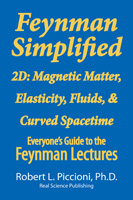|
2D: Magnetic Matter, Elasticity,
Fluids, & Curved Spacetime
Feynman
Simplified 2D covers
the last
quarter of
Volume 2, the freshman course, of The Feynman Lectures
on Physics. The topics we explore include:
- Principle of Least Action
- Tensors in 3-D and 4-D Spacetime
- Magnetic Materials
- Diamagnetism & Paramagnetism
- Ferromagnetism
- Elasticity & Elastic Matter
- Viscosity & Liquid Flow
- Gravity and Curved Spacetime
Excerpt:
What is a
Tensor?
Tensors are a
generalization of vectors. Tensor calculus is a beautiful branch of
mathematics that empowers us to elegantly and effectively describe many
complex, multi-dimensional phenomena.
Tensors are essential in general relativity, where 4-D spacetime
curves, twists, and stretches differently at every point, at every
instant, and in every direction.
Tensors are also employed in 3-D analyses of mechanics and wave
propagation in anisotropic materials, those whose properties are
different in different directions.
The most important thing to know about tensors is that any tensor
equation that is valid in one coordinate system is automatically valid
without any modifications in all coordinate systems, regardless of
their rotation or motion relative to the original coordinate system.
That generality is one reason that the mathematics of general
relativity is so challenging, but it is also one of the most powerful
tools in solving problems. If we can identify a coordinate system in
which we can solve a complex problem with a tensor equation, we have
immediately solved the problem in all coordinate systems. General
relativity is the only major branch of physics in which tensor
equations are universally employed.
Tensors are arrays of components that transform properly between
coordinate systems. In 3-D, they transform according to Euclidian
coordinate rotations. In 4-D spacetime, they also transform according
to the Lorentz transformation.
Let’s consider some quantities that are not tensors.
Temperature is a simple quantity that changes with time and location,
making it a function of the four coordinates of spacetime. Its values
are different in different coordinate systems, but the values do not
change according to the rotation matrices or the Lorentz
transformation. Hence, temperature is not a tensor.
Similarly, energy by itself is not a tensor. But, the proper
combination of energy and momentum — (E/c, px, py, pz) — is a tensor
because its components do transform properly.
|


